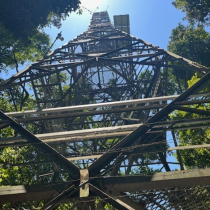Monitoring ecological change with a growing network of phenocams
April 12, 2016
Phenology—the study of how nature changes seasonally—is a core focus of NEON science. Studying how plants, insects and animals respond to seasonal changes is central to increasing scientists’ understanding of how variations in climate impact life cycle patterns of plant, insect and animal communities.
NEON gathers phenological data at its field sites through various methods including field sampling of specific plants and insects, flyovers to collect remote sensing data and in situ phenocams that collect phenology image data. These data are hosted on the PhenoCam Gallery and also accessible via the NEON data portal.
Using NEON field sites to expand the coverage of phenocams
A “phenocam,” is a digital camera set up at a fixed location to capture time-lapse images. Over time, these data provide a near-continuous visual record of the environment around the camera. NEON’s connections to phenocam data collection began as early as 2006, when Northern Arizona University professor, Andrew Richardson, encouraged NEON to add phenocams as a data collection method, preferably in close proximity to other in situ sensors and field sampling plots. NEON accepted the recommendation and will install phenocams at all of its field sites. This expansion of phenocam coverage across varying U.S. ecosystems will help scientists study and forecast ecological change over time, and at the local, regional, and continental scales. In addition, NEON will closely follow PhenoCam Network protocols for collecting phenology data, allowing scientists to easily compare and integrate NEON data into their own research.
“It’s really exciting to see a continental-scale network of field sites incorporate phenocams into their design,” says Richardson. “Over the 30-year duration of NEON, these data will be invaluable for tracking changes in ecosystem structure and composition.” The need for more phenocam data and standardized data collection practices across networks is reiterated in a paper that was recently published in Frontiers in Ecology. The paper, titled “Using phenocams to monitor our changing earth: toward a global phenocam network,” was co-authored by Richardson and other scientists including three NEON staff members.
Collaborating across disciplines to determine best practices for phenocam data collection
The paper is one of the results of a National Science Foundation funded workshop that took place at NEON in October 2013. Workshop participants came from a wide variety of backgrounds and interests including ecosystem ecology, remote sensing (using airborne and satellite platforms), unmanned aerial vehicles (UAVs or drones), sensor networks, modeling, on-the-ground phenology, engineering and citizen science.
The co-authors and workshop participants concluded that with the right best practices and systems in place, high-quality, affordable digital cameras or ‘phenocams’ can help “bridge the gap between satellite monitoring and traditional on-the-ground observations.” The recommendations they go on to describe exemplify an emerging theme in ecology that networks like NEON help to address—the burgeoning need for data standards, open access data and more data to tackle larger ecological questions. Specifically, the authors recommend the need for global data standards for phenocam-collected data; a centralized and open-access database of phenocam data; additional networks of phenocams; and the potential impact of citizen science for both image collection and analysis.
Why is phenocam phenology data important?
According to Richardson, “phenology data derived from camera imagery provide a lot of information about the seasonality of ecosystem-atmosphere CO2 fluxes and ecosystem productivity. The data can be used to test and improve models of vegetation phenology. Ecologists can quantify the differences in phenology among competing species. The remote sensing community can use the data to validate satellite data products. Earth system modelers can use the data to benchmark land surface models.” In addition, phenology is an ideal topic for engaging the general public about “the biological impacts of climate change, and the environmental pressures that are facing human society in the 21st century. The passing of the seasons is something to which people are naturally drawn. Shifts in dates of leaf out or autumn coloring - ‘e.g. spring is coming a week earlier than it was just a few decades ago’ - are a powerful and tangible example of climate change impacts.”
Phenology and citizen science
Expanding phenocam coverage is an important piece of phenology research, however, being able to analyze and classify images reveals another challenge for researchers. Many scientists have turned to citizen science as a crowdsourcing solution. With funding from NSF, Richardson and his postdoc, Margarate Kosmala worked with Sandra Henderson, a co-author on the Frontiers paper to create a pilot project that would engage citizen scientists in the classification of images already captured by the PhenoCam Network. The result was Season Spotter, a Zooniverse citizen science program. Citizen scientists involved in Season Spotter identify phenological events and classify vegetation in PhenoCam imagery. Richardson says, “This results in scientifically valuable data that will be used to develop new automated image analysis methods.”
Season Spotter is an ideal complement another citizen science program. Project BudBurst, where participants go outside and make ground-level observations of phenological changes in plants through the seasons.
All the observations submitted to Project BudBurst are added to an open access nationwide research database, providing additional data coverage of plant phenology events across the United States. The protocols Project BudBurst follows are also very similar to the plant phenology protocols NEON scientists follow at field sites.
As mentioned at the beginning of this article, NEON phenocam data are hosted by the PhenoCam Network’s PhenoCam Gallery. It is one of the largest cooperative, open access databases in the world of canopy phenology image data. Users can easily search and work with phenology data from all across the country. Explore NEON's complete suite of phenology data products on the NEON Data Portal.


